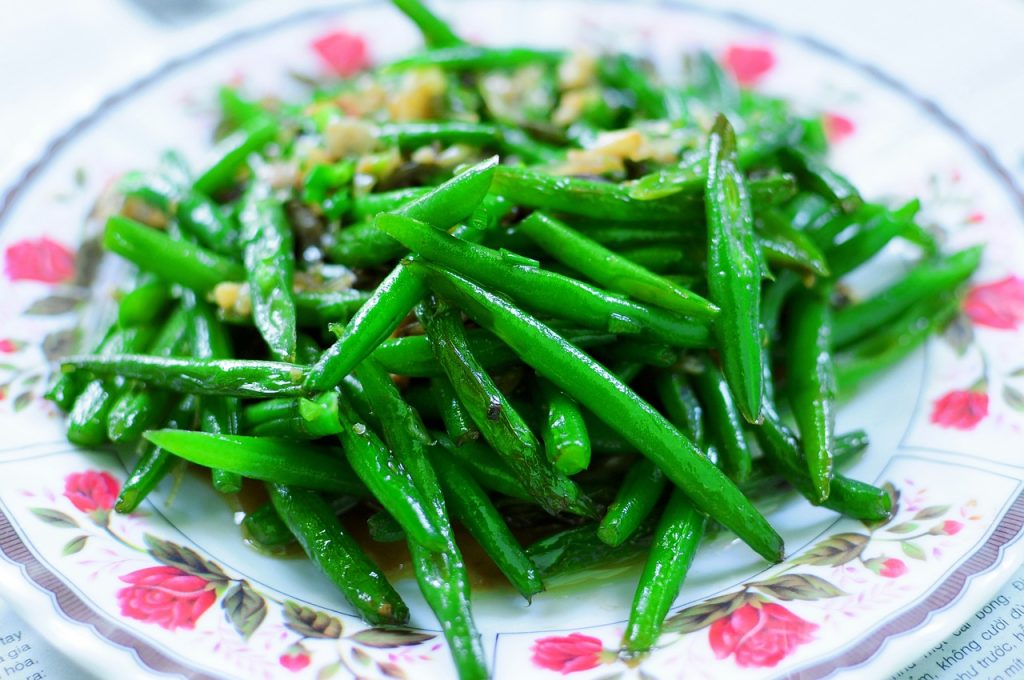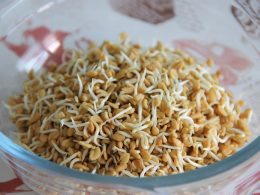Table of Contents
Green beans are a nutritious and versatile vegetable that are enjoyed around the world. Also known as string beans or snap beans, they are a popular addition to salads, casseroles, and other dishes. But besides their delicious taste, green beans also offer a range of potential health benefits. They are packed with vitamins, minerals, and fiber, which make them a valuable addition to any healthy diet. In this article, we will explore the nutritional facts about green beans and their potential health benefits in detail. So, whether you’re a fan of green beans or looking to add more variety to your diet, read on to learn more about this amazing vegetable.

Nutritional Facts about Green Beans
Green beans are low in calories and high in nutrients, making them an excellent addition to any healthy diet. One cup of cooked green beans (about 125 grams) contains the following nutrients:
- Calories: 44
- Protein: 2 grams
- Fat: 0.4 grams
- Carbohydrates: 10 grams
- Fiber: 4 grams
- Vitamin C: 12% of the RDI
- Vitamin K: 19% of the RDI
- Folate: 10% of the RDI
- Iron: 6% of the RDI
- Magnesium: 6% of the RDI
- Potassium: 8% of the RDI
Types Of Beans
Kidney beans
These large, kidney-shaped beans are a great source of plant-based protein and are commonly used in chili, soups, and stews.
Black beans
Black beans are a staple in Latin American cuisine and are often used in dishes like rice and beans, tacos, and salads. They are a good source of fiber and protein.
Navy beans
Also known as haricot beans, navy beans are small, oval-shaped beans with a mild flavor. They are commonly used in baked beans and soups.
Lima beans
Lima beans are large, flat beans with a buttery flavor. They are often used in stews, soups, and casseroles.
Chickpeas
Also known as garbanzo beans, chickpeas are a versatile legume that can be used in many dishes, including hummus, salads, and curries. They are a good source of protein and fiber.
Cannellini beans
These large, white beans have a creamy texture and a mild, nutty flavor. They are commonly used in Italian dishes like minestrone soup and pasta e fagioli.
Pinto beans
Pinto beans are a popular bean in Mexican cuisine and are often used in refried beans, burritos, and chili. They are a good source of protein, fiber, and iron.
Lentils
Although technically not a bean, lentils are a type of legume that are often used as a meat substitute in vegetarian dishes. They come in many different colors, including green, brown, and red, and are a good source of protein and fiber.
Potential Health Benefits of Green Beans
Improved Digestive Health
Green beans are a great source of dietary fiber, which can help promote healthy digestion and prevent constipation. One cup of raw green beans contains about 2.7 grams of fiber, or about 11% of the recommended daily value. The fiber in green beans can also help regulate blood sugar levels and lower cholesterol.
Fiber is an essential nutrient that helps keep the digestive system running smoothly. It helps add bulk to stool, which can help prevent constipation and promote regularity. Fiber also helps feed the healthy bacteria in the gut, which can help maintain a healthy digestive system.
Reduced Risk of Chronic Diseases
Green beans are rich in antioxidants, which can help protect against oxidative damage and reduce the risk of chronic diseases. Antioxidants are compounds that can neutralize harmful molecules called free radicals, which can damage cells and contribute to the development of chronic diseases such as cancer, heart disease, and Alzheimer’s disease.
In particular, green beans are rich in carotenoids, which are a type of antioxidant that can help protect against a range of chronic diseases. One carotenoid found in green beans is beta-carotene, which the body can convert into vitamin A. Beta-carotene has been shown to have anti-cancer properties and may help reduce the risk of lung, prostate, and breast cancers.
Better Eye Health

Green beans are a good source of several nutrients that are important for maintaining healthy eyes. Specifically, green beans contain high levels of two antioxidants, lutein and zeaxanthin, which have been shown to promote eye health and reduce the risk of age-related macular degeneration (AMD) and cataracts.
Lutein and zeaxanthin are carotenoids that are found in high concentrations in the macula, a small area in the center of the retina that is responsible for sharp, detailed vision. These antioxidants help protect the macula from oxidative damage caused by exposure to blue light and other harmful molecules.
Several studies have shown that increasing dietary intake of lutein and zeaxanthin can help reduce the risk of AMD, a leading cause of blindness in older adults. In addition, these antioxidants may help reduce the risk of cataracts, a clouding of the lens in the eye that can cause vision loss.
Weight Loss

Green beans are a low-calorie, nutrient-dense food that can be a valuable addition to a weight loss diet. One cup of raw green beans contains only about 31 calories, making them an excellent option for people who are trying to lose weight or maintain a healthy weight.
In addition to being low in calories, green beans are also high in fiber. Fiber is an essential nutrient that helps promote feelings of fullness and can help control appetite. By adding green beans to your diet, you may be able to reduce your overall calorie intake without feeling hungry or deprived.
Bone Health
Green beans contain several nutrients that are important for maintaining strong, healthy bones. One of these nutrients is vitamin K, which plays a crucial role in bone metabolism and helps improve bone density.
Green beans also contain calcium, a mineral that is essential for building and maintaining strong bones. Calcium is the primary component of bones and helps keep them strong and resilient. In addition, green beans are a good source of magnesium, which is necessary for the absorption and utilization of calcium in the body.
Improved Cardiovascular Health
Green beans may also contribute to improved cardiovascular health. They are a good source of potassium, a mineral that can help lower blood pressure and reduce the risk of cardiovascular disease.
Green beans also contain flavonoids, plant compounds that have antioxidant and anti-inflammatory properties. Research has suggested that flavonoids may help improve heart health by reducing inflammation and improving blood vessel function.
Cancer Prevention

Green beans contain several compounds that may help prevent cancer. One of these compounds is chlorophyll, a pigment that gives green beans their characteristic color. Chlorophyll has been shown to have anti-cancer properties and may help protect against the development of certain types of cancer, including colon cancer.
Green beans are also a good source of flavonoids, plant compounds that have antioxidant and anti-inflammatory properties. These properties may help prevent damage to cells that can lead to the development of cancer.
Anti-inflammatory Properties
Green beans contain several compounds that have anti-inflammatory properties. Inflammation is a natural response of the body to injury or infection, but chronic inflammation can contribute to the development of a variety of diseases, including arthritis, heart disease, and cancer.
One of the compounds found in green beans that has anti-inflammatory properties is quercetin, a flavonoid that has been shown to help reduce inflammation in the body. Quercetin may also help reduce the risk of heart disease by improving blood vessel function and reducing the risk of blood clots.
Lower Risk of Type 2 Diabetes
Green beans may help lower the risk of developing type 2 diabetes. They are a low-glycemic-index food, meaning they don’t cause a rapid spike in blood sugar levels. This is because they are high in fiber, which slows down the absorption of glucose into the bloodstream.
Studies have suggested that a high-fiber diet can help reduce the risk of developing type 2 diabetes by improving insulin sensitivity and reducing inflammation. Insulin is the hormone that helps regulate blood sugar levels, and insulin sensitivity refers to how well the body responds to insulin.
Improved Immune Function
Green beans can help improve immune function due to their high nutrient content. They are an excellent source of vitamin C, a powerful antioxidant that helps protect the body against infections and diseases by supporting the immune system.
Vitamin C stimulates the production of white blood cells, which are the cells responsible for fighting off infections and diseases. It also helps protect white blood cells from damage by free radicals, which are harmful molecules that can cause oxidative stress and damage to cells.
Green beans are also a good source of other nutrients that support immune function, including vitamin A, vitamin K, and folate. Vitamin A helps regulate the immune system by promoting the growth and differentiation of immune cells, while vitamin K helps regulate inflammation in the body.
Beneficial During Pregnancy

Rich in Folic Acid
Green beans are an excellent source of folic acid, a crucial nutrient for the healthy development of the fetus. Folic acid can reduce the risk of neural tube defects, such as spina bifida, in the developing baby.
Low in Calories
Green beans are low in calories, making them an ideal food for weight management during pregnancy.
High in Fiber
The high fiber content in green beans can aid in digestion and reduce the risk of constipation, which is a common problem during pregnancy.
Contains Essential Nutrients
Green beans are loaded with essential nutrients such as vitamins A, C, K, and B6, as well as minerals such as iron, calcium, and potassium.
Promotes Heart Health
The high potassium content in green beans can help regulate blood pressure and promote heart health during pregnancy.
Boosts Immune System
The high vitamin C content in green beans can help boost the immune system and protect the mother and fetus from infections.
Supports Bone Health
The high calcium content in green beans can support bone health and reduce the risk of osteoporosis during pregnancy.
Enhances Mood
Green beans contain folate, which can enhance mood and reduce the risk of depression during pregnancy.
Can Reduce the Risk of Gestational Diabetes
The low glycemic index of green beans can help regulate blood sugar levels and reduce the risk of gestational diabetes during pregnancy.
Versatile and Easy to Prepare
Green beans are versatile and easy to prepare, making them a convenient and healthy addition to any pregnancy diet.
Incorporating Green Beans into Your Diet

As a side dish
Green beans make a great side dish for any meal. Simply steam or blanch them and serve them with a little salt, pepper, and butter.
In a stir-fry
Add some green beans to your next stir-fry for a boost of color, flavor, and nutrition.
In a salad
Green beans can add a nice crunch to any salad. Simply blanch them and toss them with your favorite greens, dressing, and toppings.
In a soup
Green beans are a great addition to any soup, whether it’s a classic vegetable soup or a hearty minestrone.
Grilled or roasted
Grilled or roasted green beans make a tasty and healthy snack or side dish. Simply toss them with some olive oil, salt, and pepper and cook them on a grill or in the oven until they are tender and slightly charred.
In a casserole
Green bean casserole is a classic dish that’s perfect for holidays or special occasions. Simply mix blanched green beans with cream of mushroom soup, fried onions, and seasoning and bake until bubbly.
In a pasta dish
Green beans can add some color and nutrition to your favorite pasta dish. Simply blanch them and toss them with your cooked pasta and sauce.
In a sandwich or wrap
Add some green beans to your sandwich or wrap for some extra crunch and nutrition.
Pickled or fermented
Pickled or fermented green beans make a tasty and healthy snack or addition to any charcuterie board.
In a smoothie
Green beans may not be the first ingredient that comes to mind when making a smoothie, but they can add some extra nutrition and fiber. Simply blend them with your favorite fruits and veggies for a tasty and healthy drink.
Adverse Effects of Beans
Anti-Nutrients
Beans contain compounds known as anti-nutrients, including phytic acid, lectins, and protease inhibitors. These compounds can interfere with the absorption of essential nutrients and lead to mineral deficiencies.
Gastrointestinal Distress
Beans contain complex carbohydrates that can be challenging to digest, leading to gas, bloating, and abdominal discomfort.
Food Poisoning
Improper storage and handling of beans can lead to contamination with bacteria, such as E. coli or Salmonella, causing food poisoning.
Allergic Reactions
Some people may have an allergic reaction to beans, causing symptoms such as hives, itching, and difficulty breathing.
Interference with Medications
Beans contain compounds that can interact with certain medications, such as monoamine oxidase inhibitors (MAOIs) used to treat depression.
FAQs
Q. Are canned green beans as nutritious as fresh green beans?
A. Canned green beans are still a good source of nutrients, but they may contain added salt and preservatives. Fresh or frozen green beans are a healthier option.
Q. Can green beans cause gas?
A. Green beans are high in fiber, which can cause gas in some people. If you experience digestive issues after eating green beans, try cooking them thoroughly or soaking them in water before cooking.
Q. How should I store green beans?
A. Green beans should be stored in a plastic
Conclusion
Green beans are a nutritious and versatile vegetable that can be easily incorporated into your diet. They are packed with vitamins, minerals, and fiber, which make them a valuable addition to any healthy meal plan. By including green beans in your diet, you can enjoy a range of potential health benefits, such as improved digestion, reduced risk of chronic diseases, better eye health, and weight loss. Whether you roast them, add them to salads, or cook them in casseroles, green beans are a delicious and nutritious vegetable that everyone can enjoy. So, next time you’re at the grocery store, make sure to add some fresh green beans to your cart and start enjoying all the nutritional benefits they have to offer!















